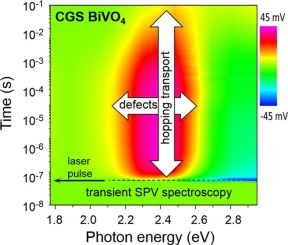Catalysis Today ( IF 5.2 ) Pub Date : 2018-02-21 , DOI: 10.1016/j.cattod.2018.02.027 Steffen Fengler , Thomas Dittrich , Mauricio Schieda , Henning Gutzmann , Thomas Emmler , Maria Villa-Vidaller , Thomas Klassen

|
Electronic states in BiVO4 powders and in cold gas sprayed BiVO4 coatings were characterized by modulated and transient surface photovoltage (SPV) spectroscopy. The SPV signals measured in the spectral ranges between 2.2 and 2.5–2.6 eV and above 2.6 eV were negative and positive, respectively. Therefore, electrons (holes) photo-generated from defect states near the surface or photo-generated by fundamental absorption in the bulk were predominantly separated towards the bulk (surface) or towards the external surface (bulk), respectively. Bulk defect states dominating the modulated SPV signals between 1.8 and 2.2 eV were observed after cold gas spraying but disappeared after moderate post-annealing. Random walk simulations of SPV signals gave evidence for transport limitation by hopping for excitation from defect states.
中文翻译:

BiVO 4粉末和冷气喷涂层的表面光电压技术表征
BiVO 4粉末和冷气喷涂BiVO 4中的电子态通过调制和瞬态表面光电压(SPV)光谱对涂层进行表征。在2.2和2.5–2.6 eV之间和2.6 eV以上的光谱范围内测得的SPV信号分别为负和正。因此,从表面附近的缺陷状态光产生的电子或通过本体中的基本吸收而光产生的电子(空穴)分别主要朝向本体(表面)或朝向外表面(本体)分离。在冷气喷涂后,观察到在1.8和2.2 eV之间占调制SPV信号主导的整体缺陷状态,但在适度的后退火后消失了。SPV信号的随机游走模拟通过跳跃从缺陷状态激发而为传输限制提供了证据。











































 京公网安备 11010802027423号
京公网安备 11010802027423号